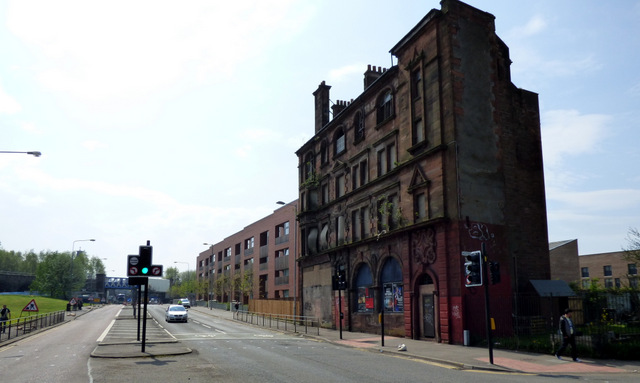NS5864 : Gorbals Street
taken 8 years ago, near to Glasgow, Scotland

Located at 162-170 Gorbals Street, the Category A Listed building Link
is the last of the traditional sandstone tenements in the Gorbals area.
The Historic Scotland listing describes it as follows...
"James Salmon, Jun. 1900. Former British Linen Bank, shop and flats with Glasgow style detailing. 4-storey 6-bay red ashlar.
Ground floor: close entrance flanked by shop and 2 round arched windows with radial glazing to bank.
Bank entrance: fine wrought-iron gate under round arch supported by columns between channelled pilasters. Scroll inscribed "British Linen Company Bank". Cornices over ground and 1st floors.
1st and 2nd floors single and bipartite windows in Gibbs surrounds with canted bay window, S, rising into 2nd
floor.
3rd floor semi circular and basket arched windows with an arts and craft iron balcony ovr (sic) canted bay.
N bay treated as a tower with small windows, having steep pediments on 1st and 3rd floors. Turret missing.
Sash and case windows with wooden mullions and transoms on 3rd floor. Slate roof. 3 ridge and 1 wallhead ashlar stacks. Rubble rear."
The Canmore web site Linkadds the following...
"The British Linen Bank (initially called the British Linen Company) was established by a Royal Charter in 1746. The new company was empowered to "carry on the Linen Manufactory" in all its branches, the word 'British' in its title was a reflection of the suspicion aroused by all things Scottish after the Jacobite Rebellion of 1745. Although the initial aim of the company was to promote the linen industry, from the late 1760s, it moved towards banking and began issuing notes. The bank continued to grow throughout the 19th century. Other than a temporary paralysis in trade in the late 1850s following the collapse of the Western Bank (along with the suspension of the City of Glasgow Bank), the British Linen Company survived most economic depressions relatively unscathed. In 1906 the company formally changed its name to the British Linen Bank. (LLoyds Banking Group archive)"
Plans are in place to save and restore the building as part of the wider regeneration of the Laurieston area. This will return the upper floors to residential use, with the ground floor to be developed as community facilities.
